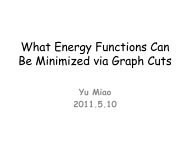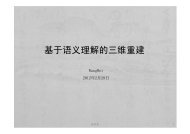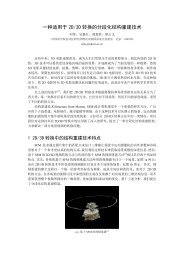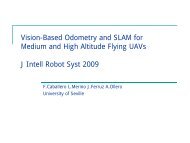Rotationally Invariant Descriptors using Intensity Order ... - IEEE Xplore
Rotationally Invariant Descriptors using Intensity Order ... - IEEE Xplore
Rotationally Invariant Descriptors using Intensity Order ... - IEEE Xplore
Create successful ePaper yourself
Turn your PDF publications into a flip-book with our unique Google optimized e-Paper software.
This article has been accepted for publication in a future issue of this journal, but has not been fully edited. Content may change prior to final publication.<br />
<strong>IEEE</strong> TRANSACTION ON PATTERN ANALYSIS AND MACHINE INTELLIGENCE 10<br />
pooling local features according to intensity orders. The proposed two descriptors are not only<br />
inherently rotation invariant, but also more distinctive than state-of-the-art local descriptors as<br />
shown by experiments in Section V.<br />
recall<br />
recall<br />
1<br />
0.9<br />
0.8<br />
0.7<br />
0.6<br />
0.5<br />
0.4<br />
0.3<br />
0.2<br />
0.1<br />
New York 1 V 5<br />
Ori−DAISY<br />
DAISY<br />
Ori−SIFT<br />
SIFT<br />
0<br />
0 0.1 0.2 0.3 0.4 0.5 0.6 0.7<br />
1−precision<br />
0.8<br />
0.7<br />
0.6<br />
0.5<br />
0.4<br />
0.3<br />
(a) 45 o rotation<br />
ubc 1 V 6<br />
0.2<br />
Ori−DAISY<br />
DAISY<br />
0.1<br />
Ori−SIFT<br />
SIFT<br />
0<br />
0 0.2 0.4 0.6 0.8 1<br />
1−precision<br />
(d) JPEG compression<br />
recall<br />
recall<br />
0.9<br />
0.8<br />
0.7<br />
0.6<br />
0.5<br />
0.4<br />
0.3<br />
0.2<br />
0.1<br />
boat 1 V 3<br />
Ori−DAISY<br />
DAISY<br />
Ori−SIFT<br />
SIFT<br />
0<br />
0 0.1 0.2 0.3 0.4<br />
1−precision<br />
0.5 0.6 0.7 0.8<br />
(b) 40 o rotation + 0.75 scale changes<br />
1<br />
0.9<br />
0.8<br />
0.7<br />
0.6<br />
0.5<br />
0.4<br />
0.3<br />
0.2<br />
0.1<br />
bikes 1 V 6<br />
0<br />
0 0.2 0.4 0.6 0.8 1<br />
1−precision<br />
(e) image blur<br />
Ori−DAISY<br />
DAISY<br />
Ori−SIFT<br />
SIFT<br />
recall<br />
recall<br />
0.9<br />
0.8<br />
0.7<br />
0.6<br />
0.5<br />
0.4<br />
0.3<br />
0.2<br />
0.1<br />
EAST PARK 0 V 3<br />
Ori−DAISY<br />
DAISY<br />
Ori−SIFT<br />
SIFT<br />
0<br />
0 0.2 0.4 0.6 0.8 1<br />
1−precision<br />
(c) 50 o rotation + 0.6 scale changes<br />
0.9<br />
0.8<br />
0.7<br />
0.6<br />
0.5<br />
0.4<br />
0.3<br />
0.2<br />
0.1<br />
leuven 1 V 6<br />
Ori−DAISY<br />
DAISY<br />
Ori−SIFT<br />
SIFT<br />
0<br />
0 0.2 0.4 0.6 0.8 1<br />
1−precision<br />
(f) illumination change<br />
Fig. 3. Image matching results of SIFT and DAISY with two different orientation assignment methods. See text for details.<br />
IV. THE PROPOSED METHOD<br />
The key idea of our method is to pool rotation invariant local features based on intensity orders.<br />
Instead of assigning a reference orientation to each interest point to make the computation of local<br />
features rotation invariant, we calculate local features in a locally rotation invariant coordinate<br />
system. Thus they are inherently rotation invariant. Meanwhile, sample points are adaptively<br />
partitioned into several groups based on their intensity orders. Then the rotation invariant local<br />
November 26, 2011 DRAFT



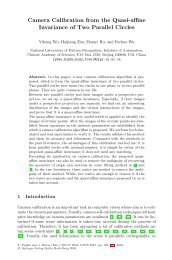
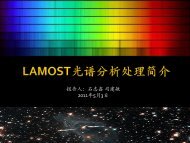
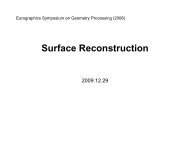
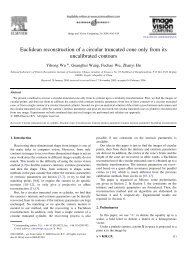
![Accurate, Dense, and Robust Multi-View Stereopsis (PMVS) [1,2,3]](https://img.yumpu.com/19388840/1/190x135/accurate-dense-and-robust-multi-view-stereopsis-pmvs-123.jpg?quality=85)


